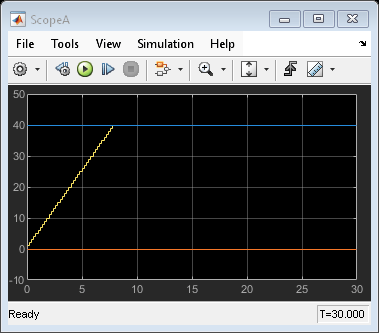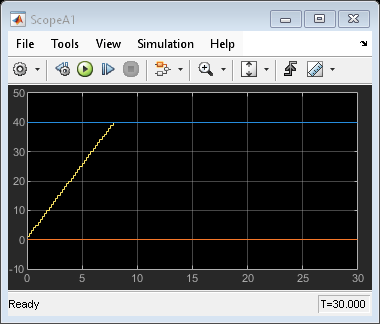Using Buses with Legacy Functions Having Structure Arguments
This example shows you how to use the Legacy Code Tool to integrate legacy C functions with structure arguments using Simulink® buses.
The Legacy Code Tool allows you to:
Provide the legacy function specification,
Generate a C-MEX S-function that is used during simulation to call the legacy code, and
Compile and build the generated S-function for simulation.
Providing the Legacy Function Specification
Functions provided with the Legacy Code Tool take a specific data structure or array of structures as the argument. The data structure is initialized by calling the function legacy_code() using 'initialize' as the first input. After initializing the structure, you have to assign its properties to values corresponding to the legacy code being integrated. The prototype of the legacy functions being called in this example is:
counterbusFcn(COUNTERBUS *u1, int32_T u2, COUNTERBUS *y1, int32_T *y2)
where COUNTERBUS is a struct typedef defined in counterbus.h and implemented with a Simulink.Bus object in the base workspace. The legacy source code is found in the files counterbus.h and counterbus.c. To open the model and files, click Open Model.
evalin('base','load sldemo_lct_data.mat') % sldemo_sfun_counterbus def = legacy_code('initialize'); def.SFunctionName = 'sldemo_sfun_counterbus'; def.OutputFcnSpec = 'void counterbusFcn(COUNTERBUS u1[1], int32 u2, COUNTERBUS y1[1], int32 y2[1])'; def.HeaderFiles = {'counterbus.h'}; def.SourceFiles = {'counterbus.c'}; def.IncPaths = {'sldemo_lct_src'}; def.SrcPaths = {'sldemo_lct_src'};
Generating and Compiling an S-Function for Use During Simulation
The function legacy_code() is called again with the first input set to 'generate_for_sim' in order to automatically generate and compile the C-MEX S-function according to the description provided by the input argument 'def'. This S-function is used to call the legacy functions in simulation. The source code for the S-function is found in the file sldemo_sfun_counterbus.c.
legacy_code('generate_for_sim', def);
### Start Compiling sldemo_sfun_counterbus
mex('-I/tmp/Bdoc25b_2988451_773493/tpdfe0b582/simulink_features-ex39753963/sldemo_lct_src', '-I/tmp/Bdoc25b_2988451_773493/tpdfe0b582/simulink_features-ex39753963', '-c', '-outdir', '/tmp/Bdoc25b_2988451_773493/tpd86374c5_869a_4c8e_acef_e2fa2a1f80db', '/tmp/Bdoc25b_2988451_773493/tpdfe0b582/simulink_features-ex39753963/sldemo_lct_src/counterbus.c')
Building with 'gcc'.
MEX completed successfully.
mex('sldemo_sfun_counterbus.c', '-I/tmp/Bdoc25b_2988451_773493/tpdfe0b582/simulink_features-ex39753963/sldemo_lct_src', '-I/tmp/Bdoc25b_2988451_773493/tpdfe0b582/simulink_features-ex39753963', '/tmp/Bdoc25b_2988451_773493/tpd86374c5_869a_4c8e_acef_e2fa2a1f80db/counterbus.o')
Building with 'gcc'.
MEX completed successfully.
### Finish Compiling sldemo_sfun_counterbus
### Exit
Generating an rtwmakecfg.m File for Code Generation
After the TLC block file is created, the function legacy_code() can be called again with the first input set to 'rtwmakecfg_generate' in order to generate an rtwmakecfg.m file to support code generation through Simulink® Coder™. Generate the rtwmakecfg.m file if the required source and header files for the S-functions are not in the same directory as the S-functions, and you want to add these dependencies in the makefile produced during code generation.
Note: Complete this step only if you are going to simulate the model in accelerated mode.
legacy_code('rtwmakecfg_generate', def);
Generating a Masked S-Function Block for Calling the Generated S-Function
After the C-MEX S-function source is compiled, the function legacy_code() can be called again with the first input set to 'slblock_generate' in order to generate a masked S-function block that is configured to call that S-function. The block is placed in a new model and can be copied to an existing model.
% legacy_code('slblock_generate', def);
Integrate the Legacy Code
The model sldemo_lct_bus shows integration with the legacy code. The subsystem TestCounter serves as a harness for the call to the legacy C function.
open_system('sldemo_lct_bus') open_system('sldemo_lct_bus/TestCounter') open_system('sldemo_lct_bus/ScopeA') open_system('sldemo_lct_bus/ScopeA1') sim('sldemo_lct_bus')
ans =
Simulink.SimulationOutput:
ScopeDataA: [301x4 double]
ScopeDataA1: [301x4 double]
tout: [301x1 double]
SimulationMetadata: [1x1 Simulink.SimulationMetadata]
ErrorMessage: [0x0 char]


